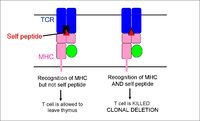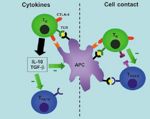Immune Tolerance
| This article has been peer reviewed but is awaiting expert review. If you would like to help with this, please see more information about expert reviewing. |
Immune Tolerance
Immunological tolerance occurs when there is an unresponsiveness towards particular antigens, so any further immune responses are prevented or suppressed. Tolerance is required to prevent:
- Potentially harmful inflammatory responses towards innocuous substances, such as air-borne or food molecules
- To prevent an immune attack against host tissue - this is known as self-tolerance
T Cell Tolerance
During T cell development within the thymus, genes encoding the T cell receptors are rearranged, resulting in adult cells that are able to recognise antigen fragments displayed by the host MHC molecule. Some receptors however will be self-reactive, i.e. they bind strongly to antigens expressed by the host's own tissues (autoantigens), inducing immune reactions that could be damaging to the host (autoimmune diseases); they must be deleted or suppressed.
Central Tolerance
Tolerance at a central level takes place within the thymus, and induces both positive and negative selections:
- During positive selection, cells passing through the thymic cortex encounter cortical epithelial cells expressing MHC molecules. Those with a suitable level of binding affinity for the MHC recieve 'survival' signals and apoptosis is prevented (at the same time cells lose either their CD4 or CD8 co-receptor)
- During negative selection, cells passing through the corticomedullary junction and thymic medulla once again encounter MHC molecules, on epithelial cells, dendritic cells and macrophages, this time bound to self-peptide. Cells bearing receptors that bind too strongly to this complex are deleted through induced apoptosis.
Peripheral Tolerance
It is inevitable that some self-reactive T cells will evade the thymic selection process and enter the peripheral circulation, because some self-antigens are not expressed in the thymus, and others will not show sufficient affinity to MHC to form the MHC:self-peptide complex required for negative selection in the thymus. Conversely some T cell receptors will not have enough affinity for their respective self-antigen to induce apoptosis. Peripheral tolerance describes an unresponsiveness towards self-antigen which is developed outside the primary lymphoid organs. There are four ways this may be achieved in T cells:
- Ignorance
- Anergy
- Cell death
- Immune deviation/suppression
Ignorance can occur when self-reactive T cells cannot penetrate an endothelial barrier, when self-antigen is present in very low amounts, when self-antigen is present on cells that do not express or express low amounts of MHC or when self-antigen is presented without co-stimulation, which can lead to ignorance or anergy, depending on the type of antigen and the affinity to the TCR. Ignorance also occurs when the T cells are not present in sufficient numbers to mount an effective response.
Anergy
- Defined as a state where the T cell is still alive, but fails to respond to stimulation from its specific T cell receptor and other receptors required for activation
- Easily induced in T cells in vivo by activation of T cell receptor without co-stimulation
- Induced in vitro by injection of potent superantigens (antigens that stimulate T cells with different receptor types, using the same T cell receptor V gene)
- Can be caused by downregulation of T cell receptors as a result of chronic stimulation
- Anergy induced without co-stimulation can be reversed by IL-2
Cell death
Peripheral deletion of T cells requires the engagement of:
- Fas by Fas ligand
- Deficiencies in Fas ligand lead to lymphoproliferative disorders
- After activation by an antigen, T cells upregulate expression of Fas ligand
- Some tissues, such as the testis and retina, constitutively express Fas ligand to protect themselves from activated T cells
- TNF via TNF receptor
- CTLA-4 recently implicated
- Subsequent signalling cascade activates proteases, such as IL-1beta Converting Enzyme (ICE), that leads to apoptosis
Immune deviation
- Th2-derived cytokines, such as IL-10, typically support antibody production, but also down-regulate macrophage effector functions, such as antigen presentation, thereby suppressing inflammatory responses
- Likewise, Th1-derived gamma-IFN can prevent Th0-Th2 differentiation
- This process is described as immune deviation, i.e. one response being selectively induced over the other
- In the case of self-antigens, autoimmune diseases such as diabetes are caused by Th1 cells and can be prevented by 'antigen-primed' Th2 cells.
Mucosal tolerance
Mucosal tolerance is the systemic unresponsiveness towards antigens administered across the mucosal surfaces
- As the highest antigenic load of the body surfaces occurs in the GI tract, it is also known as oral tolerance
- When oral tolerance towards food antigens breaks down, inflammatory autoimmune responses are induced
- Gut associated lymphoid tissue is important for developing oral tolerance:
- Animals that lack Peyer’s patches and mesenteric lymph nodes do not develop oral tolerance
- It is thought the liver and spleen may also play a role
Mechanisms
- High doses of antigen can cause anergy or cell death
- Low doses can induce a T cell response:
- The antigen is taken up and presented, inducing a Th2-like cell response
- This cell response produces cytokines that suppress the Th1 inflammatory response, such as IL-10 and TGF-beta
- Although the cellular response is antigen-specific, the cytokines released are not. TGF-beta is known to inhibit the proliferation and function of B-cells, cytotoxic T cells and NK cells. This means tolerance induction to one antigen suppresses an immune response to a second associated antigen- this mechanism has been used to suppress some autoimmune diseases by feeding with an antigen isolated from the affected tissue. This is known as ‘’bystander suppression’’.
Other mucosal surfaces
- Nasal deposition of some peptides can be used to induce tolerance, controlling both humoral and cellular responses
- Administration of antigen in aerosol form to the lung has been used to control both allergic and autoimmune responses
Regulatory T Cells
A number of cell populations identified during studies on autoimmunity and organ transplantation have shown the capacity to suppress responses to self-antigen and regulate rejection. Although once considered a tentative theory, this form of tolerance is now considered a major mechanism in the protection of host tissue from immune attack.
- Known as regulatory T cells, these CD4+ cells are antigen-specific
- Currently thought to develop in the thymus
- They usually release inhibitory cytokines, e.g. IL-4, IL-10 and TGF-beta
- When their TCRs bind to an antigen, they do not proliferate themselves but suppress the proliferation of other naive T cells responding to that antigen
- Mechanism of suppression is dependent on:
- CTLA-4 on the regulatory T cell binding with B7 on the target T cell
- Both cells binding the same antigen
- Regulatory T cells are unique in their use of a transcription repressor known as FoxP3
- Encoded by a gene on the X chromosome, rare deficiencies in FoxP3 are characterised by autoimmunity, primarily towards gut tissue, the thyroid, pancreative beta-cells and the skin. Sufferers are unable to produce regulatory T cells and the only known treatment is a bone marrow transplant from a MHC-identical sibling.

